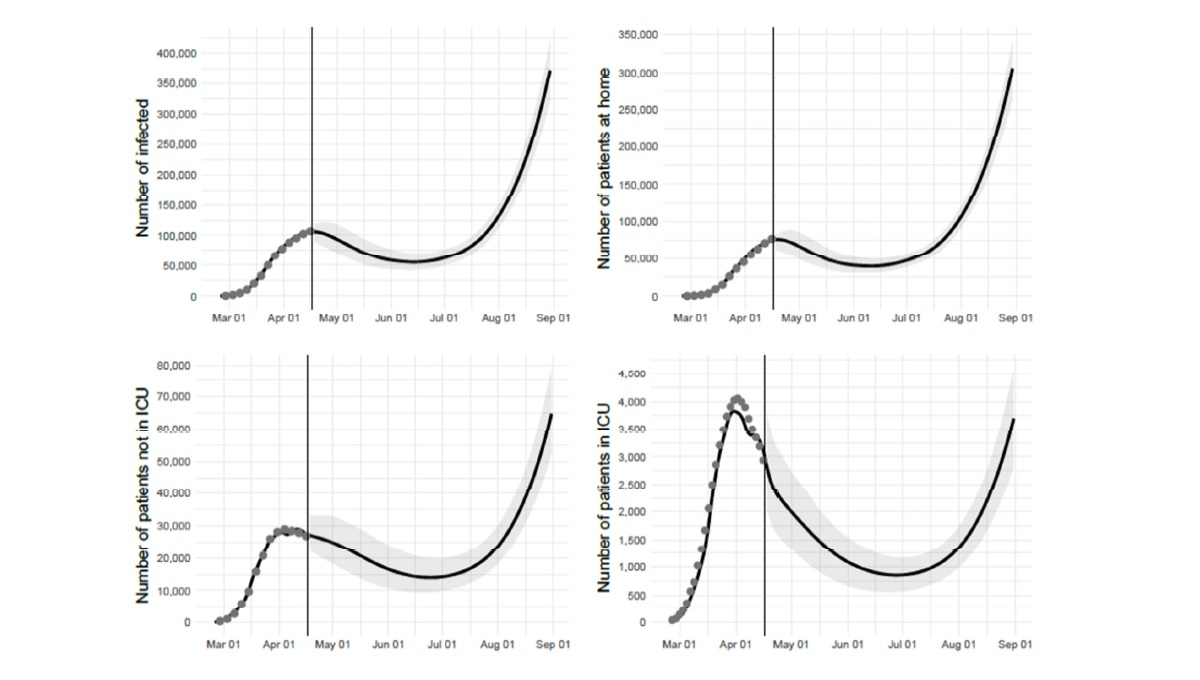Predicted effects of stopping COVID-19 lockdown on Italian hospital demand
Publication date: 22/04/2020 – E&P Code: repo.epiprev.it/1312
Authors: Jordy Bollon1, Matteo Paganini2, Consuelo Rubina3, Nello De Vita1, Rosanna Vaschetto1, Luca Ragazzoni1,2, Francesco Della Corte1,2, Francesco Barone-Adesi1,2
Abstract: Objective: Italy has been one of the first countries to implement mitigation measures to curb the COVID-19 pandemic. There is now a debate on when such measures should be loosened. Our aim was to forecast the Italian hospital demand for COVID-19 during the following months, assuming different approaches in reducing the restrictions currently in place.
Methods: We used a compartmental model to evaluate two scenarios: A) an intermittent lockdown; B) a gradual relaxation of the lockdown. Predicted intensive care unit (ICU) and non-ICU demand was compared with the peak in hospital bed utilization observed in April 2020.
Results: Under scenario A, while ICU demand will remain below the peak, the number of non-ICU will substantially rise and will exceed it (132%; 95%CI: 95-174). Under scenario B, a rise in ICU and non-ICU demand will start in July and will progressively increase over the summer 2020, reaching 91% (95%CI: 70-113) and 223% (95%CI: 180-272) of the April peak.
Conclusions: Italian hospital demand is likely to remain high in the next months if restrictions will be reduced. Planning for next months should consider a diffuse increase in healthcare resources to maintain at least the contingency level across the country.
Cite as: Jordy Bollon, Matteo Paganini, Consuelo Rubina, et. al. (2020). Predicted effects of stopping COVID-19 lockdown on Italian hospital demand. E&P Repository https://repo.epiprev.it/1312
Topic: COVID-19
Key words: capacità di intervento, COVID-19, pandemia, terapia intensiva,
AVVERTENZA. GLI ARTICOLI PRESENTI NEL REPOSITORY NON SONO SOTTOPOSTI A PEER REVIEW.
Predicted effects of stopping COVID-19 lockdown on Italian hospital demand
Info
Affiliations:
1 Translational Medicine Department, Università del Piemonte Orientale, Novara, Italy
2 CRIMEDIM – Research Center in Emergency and Disaster Medicine, Università del Piemonte Orientale, Novara, Italy
3 Department of Economics and Political Science, University della Valle d’Aosta, Aosta, Italy
Authors’ contributions: –
Competing interests: the authors declare no conflict of interest.
Funding disclosure: NA
Ethics committee approval: TThe study was based on publicly available aggregate data. No Ethics committee approval was necessary.
Copyright: Il detentore del copyright è l’autore/finanziatore, che ha concesso a “E&P Repository” una licenza per rendere pubblico questo preprint. The copyright holder for this preprint is the author/funder, who has granted E&P Repository a license to display the preprint in perpetuity.
Terms of distribution: CC BY-NC-ND

Figure 2. Observed (circles) and predicted (solid line) number of infected, patients at home, non-ICU hospitalized patients, and ICU patients over time. Scenario B (gradual relaxion of the lockdown).
References & Citations
Google Scholar

